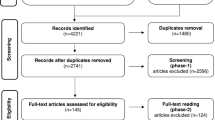Abstract
Temporomandibular disorders are among the potential comorbidities of migraine, and recent reports showed that they may have a role in promoting its progression into chronic migraine (CM). In order to clarify the possible role of neuromuscular components of the stomatognathic system in patients with CM, we studied 18 patients admitted as inpatients at our Headache Unit to undergo a withdrawal protocol for medication overuse, who underwent orthosis, after clinical and instrumental gnathological evaluation. They were subsequently evaluated after 6 months. The values of electromyographic parameters as well as of pain outcomes showed a significant decrease after orthosis. The implementation of gnathological and neuromuscular concepts can have a relevant role in the management of CM patients, in the contest of a multidisciplinary approach.




Similar content being viewed by others
References
Svensson P (2007) Muscle pain in the head: overlap between temporomandibular disorders and tension-type headaches. Curr Opin Neurol 20:320–325
Franco AL, Gonçalves DA, Castanharo SM, Speciali JG, Bigal ME, Camparis CM (2010) Migraine is the most prevalent primary headache in individuals with temporomandibular disorders. J Orofac Pain 24(3):287–292
Bevilaqua Grossi D, Lipton RB, Bigal ME (2009) Temporomandibular disorders and migraine chronification. Curr Pain Headache Rep 13(4):314–318
Bigal ME, Lipton RB (2008) What predicts the change from episodic to chronic migraine? Curr Opin Neurol 22(3):269–276
Buse DC, Manack A, Serrano D, Turkel C, Lipton RB (2010) Sociodemographic and comorbidity profiles of chronic migraine and episodic migraine sufferers. J Neurol Neurosurg Psychiatry 81(4):428–432
Grazzi L, Andrasik F, Usai S, Bussone G (2008) Headache with medication overuse: treatment strategies and proposals of relapse prevention. Neurol Sci 29(2):93–98
Evers S, Jensen R (2011) European federation of neurological societies. Treatment of medication overuse headache—guideline of the EFNS headache panel. Eur J Neurol 18(9):1115–1121
Cooper B, Kleinberg I (2009) Relationship of temporomandibular disorders to muscle tension-type headaches and a neuromuscular orthosis approach to treatment. Cranio 27(2):101–108
Manzoni GC, Bonavita V, Bussone G et al (2011) Chronic migraine classification: current knowledge and future perspectives. J Headache Pain 12:585–592
Jankelson B (1980) Measurement accuracy of the mandibular kinesiograph: a computerized study. J Prosthet Dent 44(6):656–666
Didier H, Marchetti C, Borromeo G, Tullo V, D’amico D, Bussone G, Santoro F (2011) Chronic daily headache: suggestion for the neuromuscular oral therapy. Neurol Sci 32:161–164
Jankelson B, Radke JC (1978) The Myo-monitor: its use and abuse(I). Quintessence Int Dent Dig 9(2):47–52
Bevilaqua-Grossi D, Lipton RB, Napchan U, Grosberg B, Ashina S, Bigal ME (2010) Temporomandibular disorders and cutaneous allodynia are associated in individuals with migraine. Cephalalgia 30(4):425–432
Conflict of interest
The authors declare that there is no actual or potential conflict of interest in relation to this article.
Author information
Authors and Affiliations
Corresponding author
Rights and permissions
About this article
Cite this article
Didier, H., Marchetti, C., Marchetti, A. et al. Implementing gnathological and neuromuscular concepts in patients with chronic migraine. Neurol Sci 33 (Suppl 1), 177–180 (2012). https://doi.org/10.1007/s10072-012-1078-x
Published:
Issue Date:
DOI: https://doi.org/10.1007/s10072-012-1078-x




